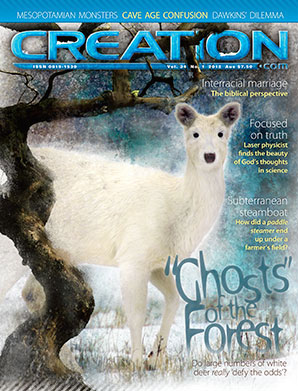Twice as wrong—and more
Fossilized eukaryote cells and giant anomalocaridids force dramatic revisions of the evolutionary timeline

The discovery of fossilized cells1 in north-west Scotland has forced a dramatic rewrite of the supposed evolutionary history of life on Earth.2 That’s because the fossil organisms were said to have lived in freshwater lakes and were ‘dated’ as being one billion years old. That is in stark contrast to previous claims that life didn’t begin its landward migration from its evolutionary starting-point in the oceans until half a billion years ago.
So these newly found fossil cells, says New Scientist, suggest that “the primitive relatives of all animals, plants and fungi had left the oceans and moved into terrestrial waters twice as long ago as thought.”3
Twice as long? No. The ‘date’ is now twice as wrong as it was before. The fossils actually date from the Flood of Noah’s day, about 4,500 years ago. The researchers noted the “exceptionally detailed three-dimensional preservation” of the fossils.2 This, in common with many other fossils found worldwide, is right in line with what one would logically expect from the global Flood.
Another recent example was the discovery of “extraordinarily well-preserved” fossils in Morocco.4,5 These were giant (length 1 metre, or 3 ft) shrimp-like creatures with soft bodies preserved along with “thousands of [other] examples of soft-bodied marine fauna” there.4 How so? They “were trapped by sediment clouds that buried them and preserved their soft bodies”.4 Note that the researchers were forced to substantially revise their timeline. They were ‘trapped’ by the evolutionary mindset that sedimentary rock layers with embedded fossils represent the order of evolution and extinction over millions of years rather than the order of burial during the Noachian Flood. They now say that “these animals existed for 30 million years longer than previously realized”.4
And the researchers also mentioned an earlier dramatic modification of the evolutionary story about these creatures. The discovery of complete specimens in the Burgess Shale showed that fossils that had been thought to be a multiplicity of different creatures actually “all belong to a single kind of animal”.5,6
These two dramatic revisions of the evolutionary timeline—500 million years and 30 million years respectively—are the latest in a long procession of spectacular rewrites of the evolution story. Nor are they likely to be the last. That’s because speculation about the past is not in the same category as a true eyewitness account of what really happened, which does not change (Deuteronomy 19:15b, 2 Corinthians 13:1, Matthew 24:35).
References
- The fossilized cells were eukaryotic cells—i.e. cells which have a membrane around the nucleus, cf. prokaryotes (bacteria), which do not. Return to text.
- Strother, P., Battison, L., Brasier, M. and Wellman, C., Earth’s earliest non-marine eukaryotes, Nature 473(7348):505–509, 2011. Return to text.
- Life had left the oceans a billion years ago, New Scientist 210(2808):20, 16 April 2011. Return to text.
- Fossil of giant ancient sea predator discovered, sciencedaily.com, 26 May 2011. Return to text.
- Van Roy, P. and Briggs, D., A giant Ordovician anomalocaridid, Nature 473(7348):510–513, 2011. Return to text.
- The name Anomalocaris means ‘abnormal shrimp’, because the first parts to be discovered were the ‘arms’ in front of the mouth. They had detached and separately fossilized, and were mistaken for strange shrimp. Then its ring mouth was discovered as a separate fossil and mistaken for a jellyfish (‘Peytoia’). Parts of the body were mistaken for a sponge (‘Laggania’). It was decades before scientists realized that they were all part of a single huge creature. The rules for naming require that the oldest name takes priority. The other names have been co-opted for other genera of anomalocaridids. Return to text.


Readers’ comments
Comments are automatically closed 14 days after publication.